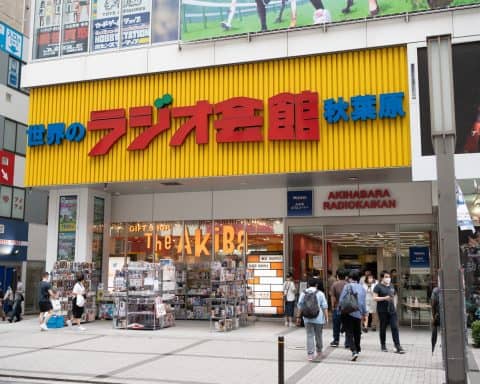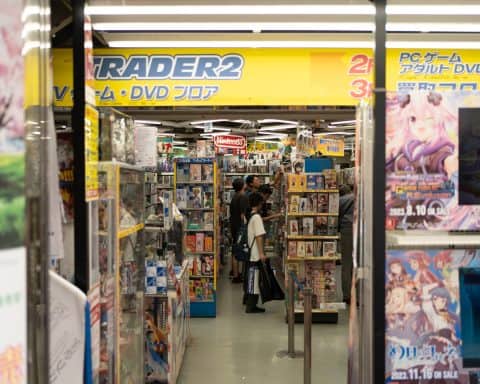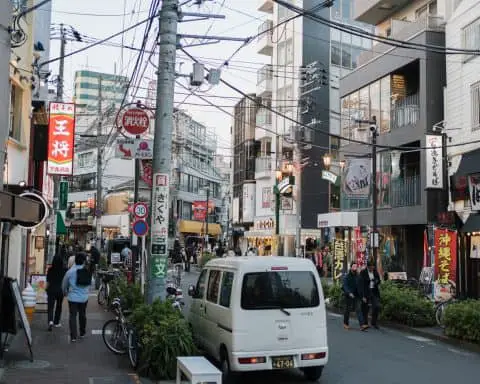I love Tokyo, it’s easily one of my top 3 cities in Japan and definitely somewhere I plan on living longer. However, it does sometimes get a little overwhelming and I often find myself looking for places close by to escape to. Two of my favorite such places are Hakone and Nikko, but which one should you visit?
If you have to chose one, Hakone will be the better option for the majority of people. Though it’s a popular area during peak season, the love people have for the area is well founded. From quaint trains and mountain hikes to cable cars and and onsen, this the place to escape to near Tokyo
While that’s my personal opinion, I still love Nikko and there’s definitely a possibility that it’ll be a better place to visit during your trip to Japan. Unsure which to chose? Let’s get into it!
Why should you trust me?
So, you’ve just booked your incredibly cheap flight to Japan, and are now hard at work planning your trip to Japan. You find yourself on this website and start to wonder, “Who the hell is this guy, and why should I trust him?” Well, let me tell you! 😉
I live and breathe Japan, and uprooted my life to live here in 2022. I spend my days creating content and helping hundreds of thousands of people each year to plan their dream trips to the land of the rising sun.
In terms of the two places in this article, I’ve been to both of them. Hakone once and Nikko 3 times. I would have been to Hakone more, but our Airbnb canceled 12 hours before and derailed our trip (that’s why I use this company now).
Though that trip got canceled, I still did a spectacular amount of research for it and know pretty much everything there is to know about Hakone. So, you’ll still get the information, just with fewer (and slightly older) photos!
This is my personal experience of both of these locations in Japan and my honest opinion on which one you should choose.
Location and accessibility
A location can look really close on the map, but if it isn’t easily accessible for the majority of people then it’s not going to score high. In Japan specifically, I want it to be easily accessible by public transport, ideally with multiple options of the type of train I can take.
If something is a little more ‘out in the sticks’ then I’m more than happy to take a bus. In case you haven’t been on one yet, they’re practically just as reliable, clean, and efficient as the trains.
Hakone
As you can see from the map above, Hakone is pretty close to Tokyo. Depending on the train you get from Shinjuku, you can expect the journey to take around 70-80 minutes with a Shinkansen and just under two hours by Local rapid and commuter trains.
Whilst you are able to just get a regular train from Shinjuku to Hakone-Yumoto, most people opt to take the Romancecar. It takes a scenic route, is far more comfortable, and is the perfect way to start your trip to Hakone.
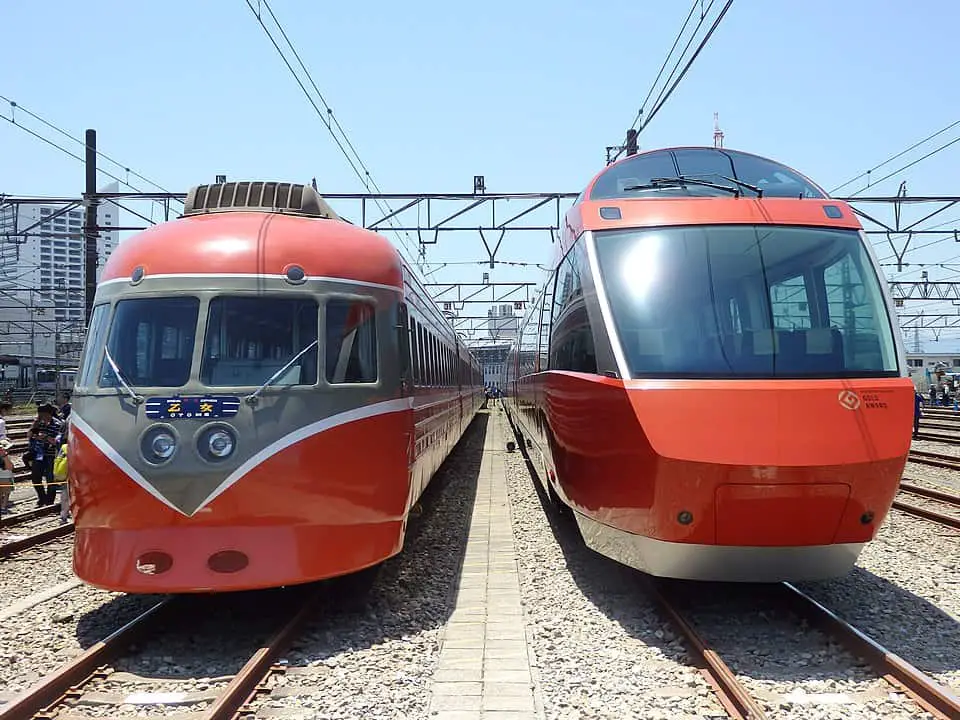
You can book the romance car online up to a month in advance for just ¥2,470 ($18.30) which includes the regular ticket. Basically, you’re paying for the privilege to go on one of these cool trains, but you also need a regular ticket to tap in and out of the train station. IC cards work fine for this part of the trip.
I would absolutely recommend booking as early as possible, especially in peak seasons. I tried so hard to get to the front of the train (seats literally at the very front of the train) but they sold out within the first 5 seconds (not even joking).
And then to top it off, a friend of mine managed to get them for herself a couple of months after…
In any case ‘splurge’ the money on these cars because they’re absolutely worth it!
Nikko
You’re most likely to visit Nikko when you’re hanging around Tokyo, so I’ll go forward thinking that’s the case. It takes just under 2 hours to get there by train and is a great spot to relax near Tokyo.
As I briefly discussed in the things you need to know before boarding Shinkansen article, I’ve used both the Limited express train and the normal commuter/rapid trains to get there. Both are suitable options, but the train you take will depend on your budget, time constraints, and the level of comfort you’re after.
The Kegon limited express trains
Cost: Around ¥3,000 ($20)
Taking the Kegon limited express train from Asakusa station in Tokyo, all the way to Tōbu-nikkō station is by far the quickest and most straightforward way to get to Nikko. As far as I’m aware, there are a couple of limited express trains that operate on this line (from Asakusa station), and some are a little faster than others.
Revaty Kegon

Spacia Kegon
The Spacia Kegon operates on the same line as the train above and it’ll just be a potluck which you get when you arrive. In case you’re wondering what it looks like, imagine a bullet train that never quite got to be a bullet train and you’ll have a rough idea. Kinda cute in my opinion.
Kinu
The Kinu train diverts a few minutes before the other trains do and travel up to Kinugawa-onsen. It’s still in Nikko and is a great area to stay at an onsen hotel if you haven’t done so yet.
No matter which train you chose, you’ll still usually only need to hop on one limited express train from central Tokyo to Nikko. In any case, it’s a very simple journey.
Depending on where you’re staying in Tokyo, google maps might like to offer you an alternative that’s just commuter or rapid trains. I’d advise against going that route because it’ll likely either include multiple transfers, there won’t be guaranteed seats, and/or it’ll be a lot more hassle for what may only save you a few yen.
Things to do
I like an area to specialize in something or be known for something if I don’t have a lot of time. I also like it to have a range of activities, though mainly things that I’m not likely to do anywhere else in Japan (or the world)
This is going to be different for each person depending on who you’re traveling with and what you enjoy doing, so I’ll let you make your own mind up!
Hakone
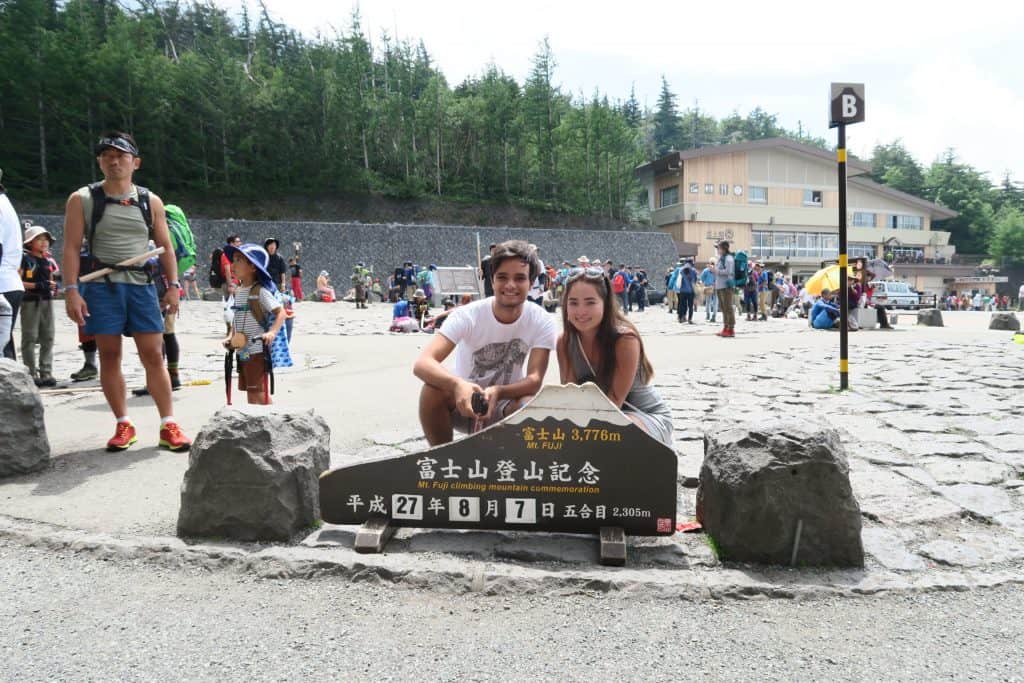
Hakone is a mountainous area. It’s the perfect place to go if you’re looking for a retreat from the hustle and bustle of Tokyo, or simply looking to reconnect with nature.
And not one of those ‘retreats’ you see in every other blog post that just ends up being a park, this is the real deal, and you’ll literally feel like you’re in the middle of nowhere. To be fair though, Nikko absolutely feels like that as well.
Being out in nature is the main pull of Hakone. We’ll talk about that and the hot spring accommodations in a minute.
Other than a load of walking trails that I’d highly recommend, there are a couple of other things you may want to visit in the area. It’s also worth noting that while I’ve technically been up Mount Fuji to the 5th station, and been to the postcard village of Oshino Hakkai in the valley below, I’ve never seen the mountain up close without clouds!
It’s annoying for sure, but it could definitely happen to you as well. Maybe not quite as fleeting as seeing the Japanese cherry blossom in full bloom, but still a gamble.
Hakone open-air museum
Hakone’s open-air museum was established in 1969 and is known for its spectacular collection of contemporary art, including sculptures, installations, and other outdoor artworks. It’s spread across 70,000 square meters and features more than 120 sculptures and installations created by artists from around the world.
One of the most popular exhibits is the Symphonic Sculpture, a massive steel structure created by Gabriel Loire. This was one of the main reasons I wanted to come here, it’s honestly hard to put into words just how cool this room looks!
Hakone Tozan Railway
The oldest mountain railway in Japan, and perhaps the coolest. Hakone Tozan Railway is a cable car (train) that connects Hakone-Yumoto and Gora station, and my word does it look like a beautiful journey.
Once again, apologies for the lack of photos, I’m planning to visit again later in 2023 to get some. Honestly having my trip canceled by Airbnb Japan ruined so much!
Hakone Ropeway
The Ropeway is the most popular attraction in Hakone, and with such incredible views over Owakudani it’s not hard to see why. If you end up going on a clear day, you should be able to see Mount Fuji, though I’d suggest it’s equally as beautiful even if it’s just peaking out of the clouds ^_^
Hakone Kowakien Yunessun
I’ve wanted to go to Kowakien Yunessun for almost the same amount of time since I knew Japan existed. Admittedly it looks a little bit tacky and slightly childish, but honestly, that doesn’t bother me.
I still haven’t managed to make that dream a reality (damn you, Airbnb!), but if you think ‘theme park’ and ‘onsen’ go together, you should absolutely check this place out!
Lake Ashi

Commonly referred to as ‘Hakone Lake’, Lake Ashi is basically a giant crater at the bottom of the ropeway. I’ve been here and we took a trip on the pirate ship above, super cool and highly recommended!
Mototsumiya Shrine

This was the other place we went to while visiting Hakone, and apart from the cloudy weather, it was a really beautiful place (which also had a cable car to get up to). This has always been one of my favorite photos I’ve taken in Japan, though I don’t think much of my younger self’s editing skills!
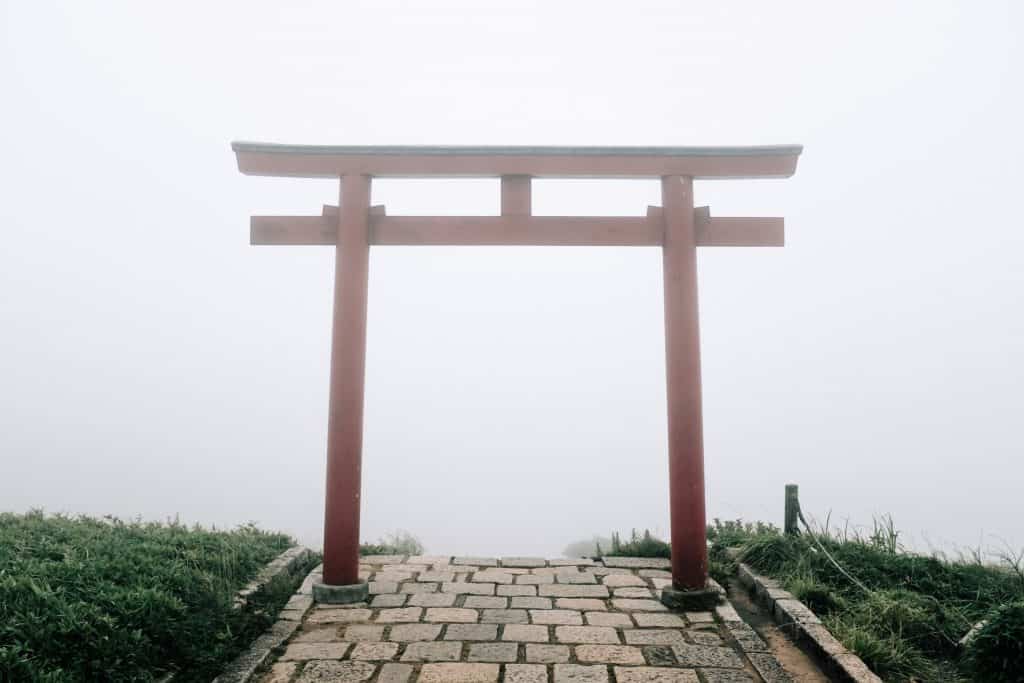
There’s something incredibly mystical about visiting a shrine in the clouds like this. In the same way that visiting Nikko temple in the rain also seems a bit special.
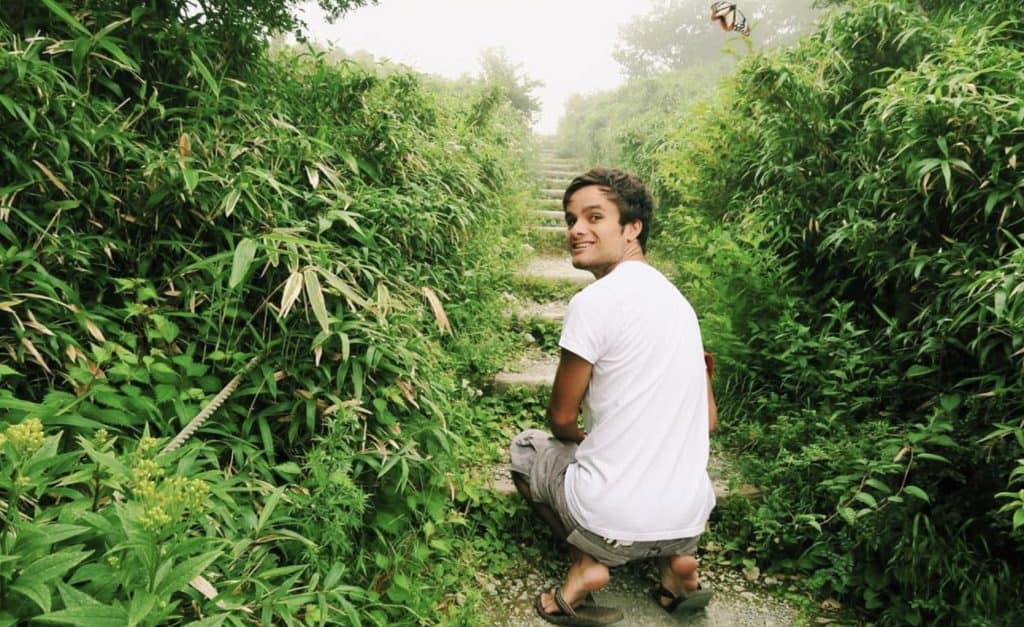
Whilst I’m sure the views are pretty incredible when the clouds go away (I’m told you can see Fuji from here), it clearly didn’t stop me from chasing butterflies and enjoying myself!
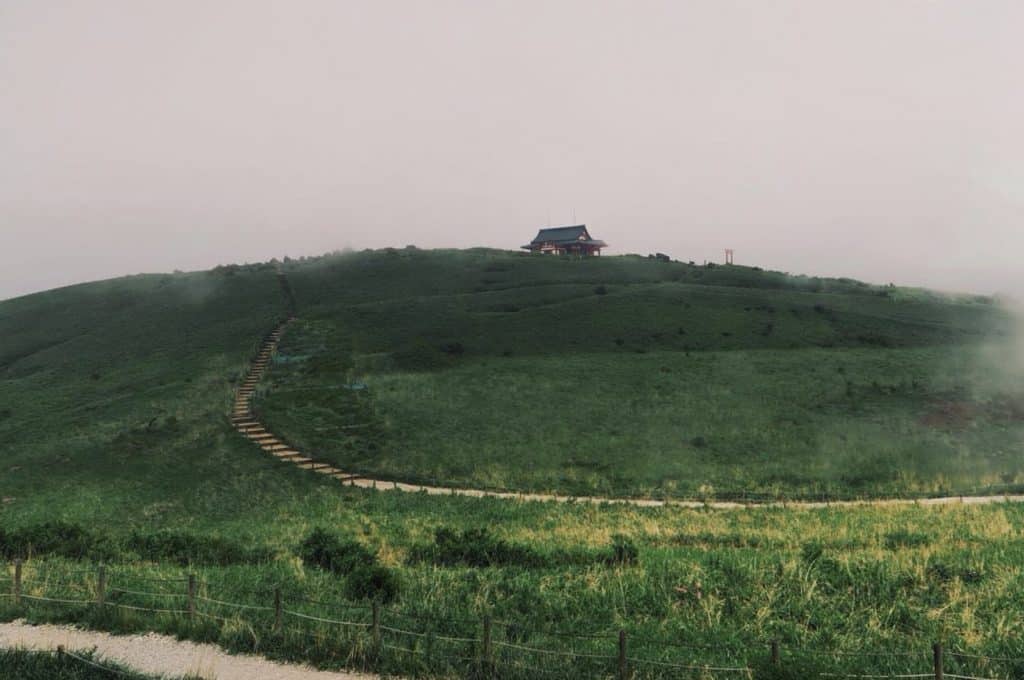
As you can see from the photo of me at the top of this section, Hakone is also very close to Mount Fuji, so if you’ve got some time to spare you might as well head over (even just to the 5th station like me!)
Nikko
Catch the steam train on the turntable
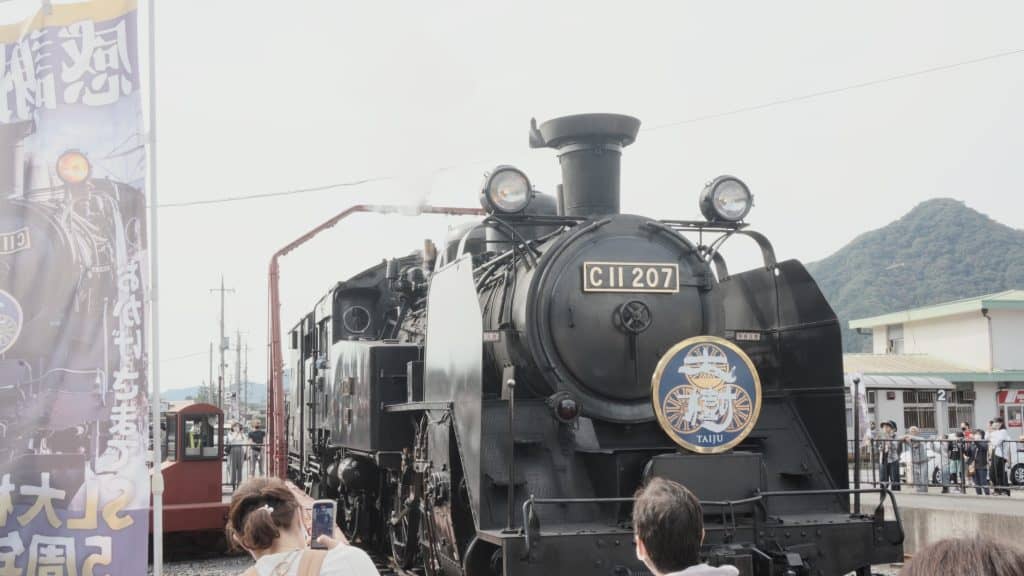
This is something I caught by chance when I visited Nikko last year, the SL/DL Taiju Steam Train on the turntable outside Kinugawa-onsen. The steam was bellowing, the horn filled the air, and everyone outside the station loved it.
Maybe it’s just because I’m a train nerd, but I’ve been here before and not seen it, so I was pretty excited! Admittedly not quite as much as when I saw Japan’s last sleeper train couple up in Okayama.
I liked that so much, I rode it twice!
Back to Nikko’s steam train, you can reserve tickets on the Tobu Railway website for a pretty cheap price. The journeys are only small, but it’s a great thing to do in Nikko if you’re a little strapped for cash but have researched beforehand.
It’s not something you can do if you’re planning on traveling around Japan without a plan, though.
Take a traditional boat ride

I can’t remember the exact name of this particular boat ride because our homestay host booked us in (and came with us!), but if you just type in ‘Kinugawaonsen River cruise’ to Google, something should come up.
It’s worth noting here that we sat cross-legged on the tatami for almost an hour before disembarking further down the river. I loved it, but I can absolutely see how this would likely be an uncomfortable experience for a lot of people
Visit the Shrines
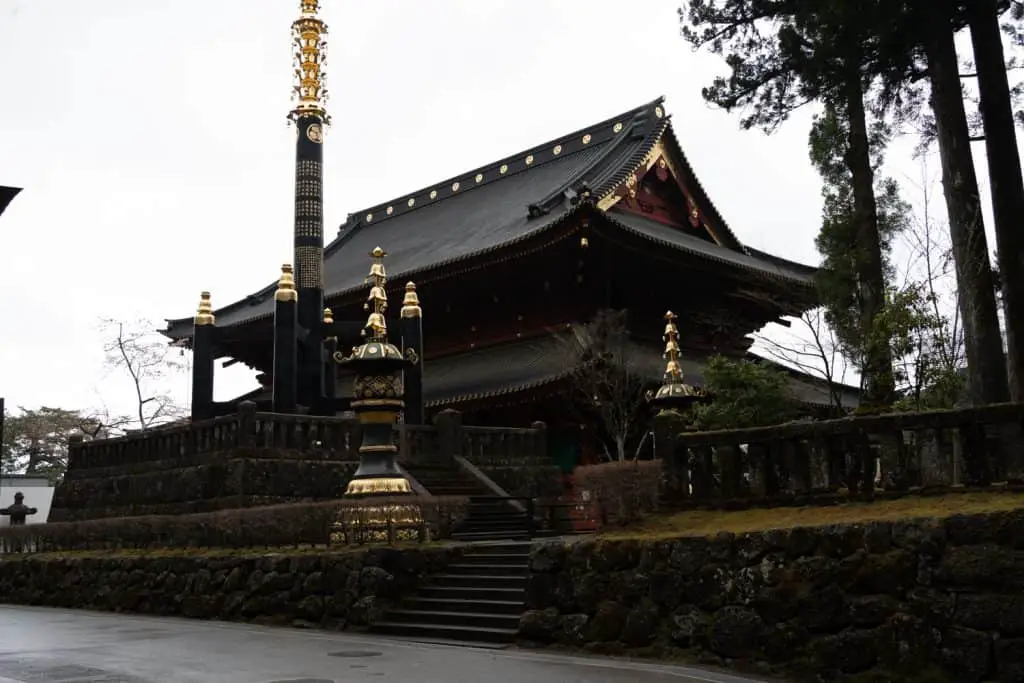
There are a number of incredibly beautiful shrines in Nikko, and it’s likely the better choice out of Hakone vs Nikko if this kind of historic tourism is what you’re looking for.
Toshogu Shrine is the biggest in the area, and probably the one you’ll want to go and visit.
I visited the main Toshogu Shrine quite a few years ago, and for the cost of ¥1300 (just under 10 dollars) to get into the main section, I think it’s definitely worth visiting at least once. As far as I’m aware all of the shrines and temples in the grounds fall under the “Toshogu Shrine” umbrella, but you only have to pay to go inside (and around the grounds of) the main building.
Shiknyo Bridge
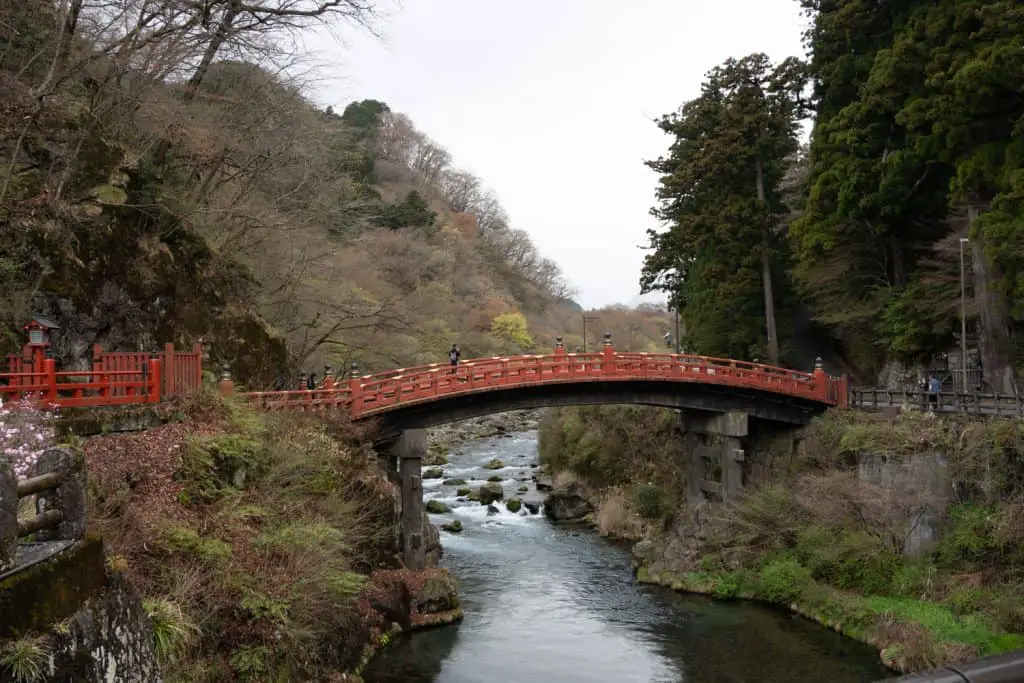
This 28-meter-long vermillion-colored bridge is one of the most well-photographed in the whole of Japan. Apparently, Shondo (the monk we talked about above) ask the mountain deities for help crossing the river, and two snakes appeared and turned themselves into a bridge.
Love a good story for places like this! It’s just at the top of the hill, within easy walking distance from the temple and Kanmangafuchi abyss.
Kanmangafuchi Abyss

This is a place I’d seen on google maps and knew I wanted to visit it (who wouldn’t with a name like ‘Abyss’??). The statues are said to protect children, women, and travelers on their journey.
It’s interesting to see how weathered many of these have become over the years they’ve been here. Some of the ones at the end are literally just stumps.
Visiting is absolutely worth it, and you can do a nice circular walk from the Shinkyo bridge that should take around an hour or so. Be warned, you’ll likely walk past FuFu Nikko which is a flipping incredible hotel that I’m jealous I can’t afford to stay at…
Tobu World Square
One stop before Kinugawa onsen is Tobu World Square, one of the most highly rated things to do in Nikko. Classed as both a museum and a theme park, Tobu World Square has 1/25 scale reproductions of 102 world-famous buildings. This is definitely one for the more nerdy travelers like me!
This one’s on my bucket list of things to do, it’s giving me major Legoland flashbacks and I love it!
Edo Wonderland
Prefer something a little more historical? Edo Wonderland is a kind of ‘History theme park’ where you can feel like you’ve stepped back in time as you wander around an Edo-style town (1603-1868). Dress in a Kimono, don some ninja attire or simply take in your surroundings.
There are loads of live-action performances, a house of illusion, a trick maze, a haunted temple, a theatre, places to throw ninja stars, and much more.
I’ve been here a few years back and it was a really cool trip. Don’t expect it to be the best thing you do in Japan, but if you’re looking for a fun day out, this is a great choice.
Lake Chuzenji
At an altitude of 1,269 meters (Japan’s highest lake), a 25km hiking trail, and some of the most spectacular views of Kegon Falls, this is easily another bucket list destination in Nikko for me.
To get there you’ll need to get on a bus headed for Okunikko Yumoto Onsen from Nikko station or Tobu Nikko station, and get off at whichever point around the lake you want to.
Accommodation
Almost always, I’d recommend going for something a little traditional to most visitors. Nikko and Hakone are two of the areas where that’s pretty damn easy to do.
Plus, as both of these areas make great day/2-day trips, you’ll only be sleeping on the floor for a single night if you realise it’s not for you! 😉
Hakone

When I went to Hakone, I stayed at a ryokan called Shiunso. The view from our window is the photo above (the rooftops), and you can see part of the room in the incredibly young photo of me below!
Basically, if you’re looking for accommodation where you literally feel like you’re in the middle of nowhere, hugged by Japan’s mountains, Hakone will have more options for you. Plus, if you’re looking to have an epic onsen experience, Hakone again is the place you should probably choose.

That’s not to say Nikko doesn’t have those places and that feel because the Kinugawa onsen area does well if that’s what you’re after, but Hakone would still be my first choice if I had to chose between the two.
Nikko
Nikko is a huge area, and as you’ll see later there’s not really a single area you should or shouldn’t stay in. My best suggestion to you would be to stay as close to one of the stations as possible, or at least within walking distance.
Staying close to a station will give you quick access to other areas in Nikko, a good amount of infrastructure, and more than enough connections with busses to get to the more remote areas. If, however, you’re planning on doing hiking or something more remote for a couple of days, it makes sense to book somewhere much closer to that activity.

When I stayed in Nikko, I went to Nikko Hoshinoyado. It was a really nice traditional Japanese hotel with onsen, tatami floors, zen gardens, all the good stuff.
At this price point, I don’t think it was anything special that you couldn’t get in Hakone. Depending on the time of year you visit, I think they’ll either be more than enough accommodation options for you not to worry (both areas are fairly big), or way too many people to get anything unless you’ve booked well in advance.
In any case, both will offer you a nice variety of hotels to choose from, though I’m personally partial to the ambiance of Hakone.
Food
Again, grab something authentic in either of these areas if you’re comfortable enough doing so. In my opinion, it would be such a shame to come all this way and then grab a Mcdonald’s…
Hakone
The food photos for Hakone are, well… non-existent. I went to Hakone well before I set this site up, and clearly, I decided that taking photos of food was best left to Instagrammers, not me.
In any case, I can remember what we ate.
As we stay in a ryokan, our dinner was a Shojin Ryori. Basically, traditional Buddhist food which in this case was brought into a room for us to enjoy while sitting on the tatami flooring.
While there are a few other food options dotted around Hakone, I’d urge you to try Shojin Ryori here if you can. Especially if you’re staying at a Ryokan.
Nikko
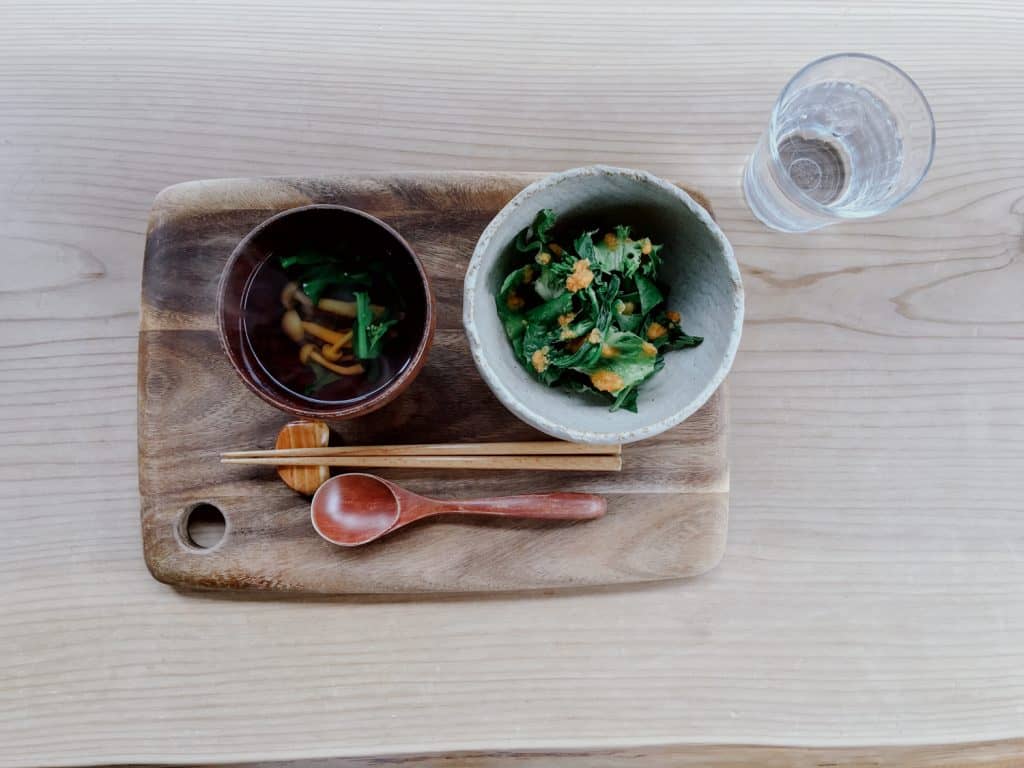
Nikko has quite a few places for food, in both the Kinugawa onsen area and the area from Tobu Nikko station. You’ll find most types of Japanese food around the area, with the slightly more expensive places around the high street.
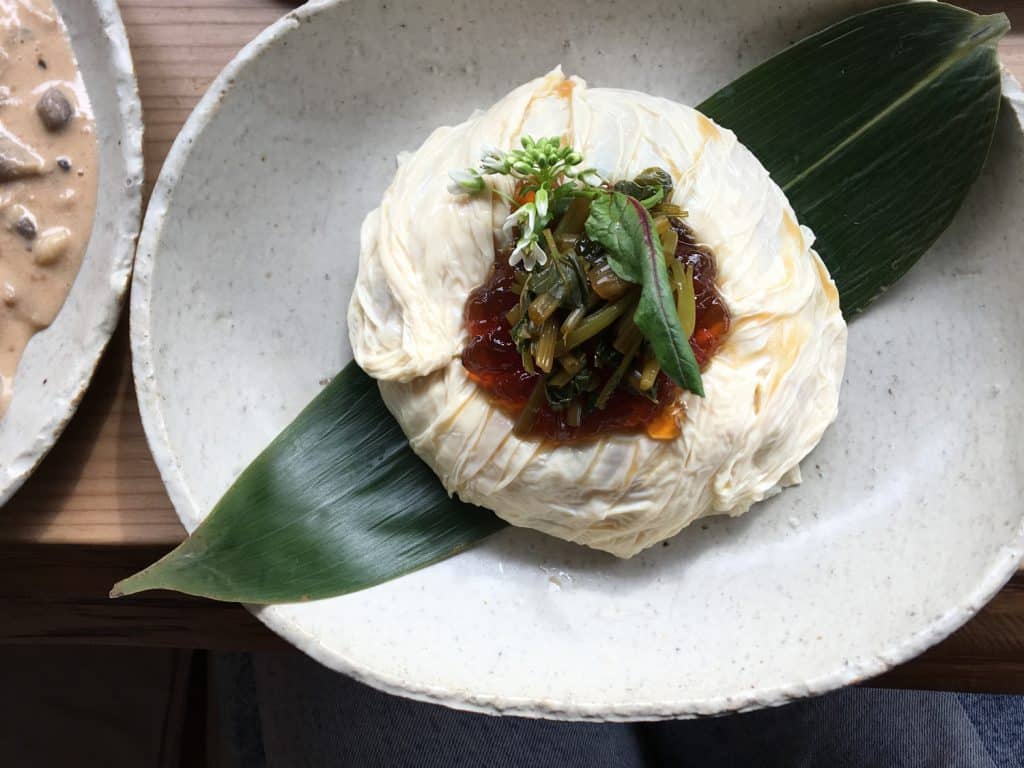
One place in particular that I love is Yasai Cafe Meguri (food pictured above). It’s a cute cafe that serves absolutely outstanding food, coffee, and tea. Plus it used to be an antique store, so the interior is incredibly aesthetically pleasing.

Another place I’d recommend is the Bell Cafe that’s just a bit past the Shinkyo Bridge. It’s literally like going to eat at your grandma’s house. I don’t want to say anymore in case I ruin the vibes, but go there if you’re looking for a meal!
Shopping
To be honest, neither is the kind of place you’d come if you’re just interested in shopping. However, they both have more than enough shops for you to bring back any kind of souvenir for your family and friends.
Hakone
Just outside Hakone-Yumoto station, you’ll find Hakone-Yumoto Shotengai, a shopping street with about 70 little shops for your to browse through.
It’s a great place to find souvenirs and doesn’t have the same intensity as some of the bigger shopping areas in Japan. Plus with a selection of cute cafes, it’s well worth checking out, especially with its proximity to the station.
Nikko
The area you stay at in Nikko will determine the amount and type of shops you’ll have access to. Up by Nikko station, you’ll find a lot of souvenir shops, a few boutique homeware shops, and one or two Konbini (convenience stores).
Further down at Shimo-Imaichi station, you’ll find some bigger stores, clothing outlets, and even a mall or two. Up in the Kinugawa onsen area, there are bigger supermarkets, barber shops, auto part stores, and independent outlets.
If you’re looking for more places to shop, Nikko is your winner as long as you stay closer to Kinugawa onsen.
Best time to visit
While I’m about to tell you the best time to visit each of these areas, there truly isn’t a bad time. If you’re in the area, you might as well go and have a look. Just be prepared that it might be a little busy at certain times.
Hakone
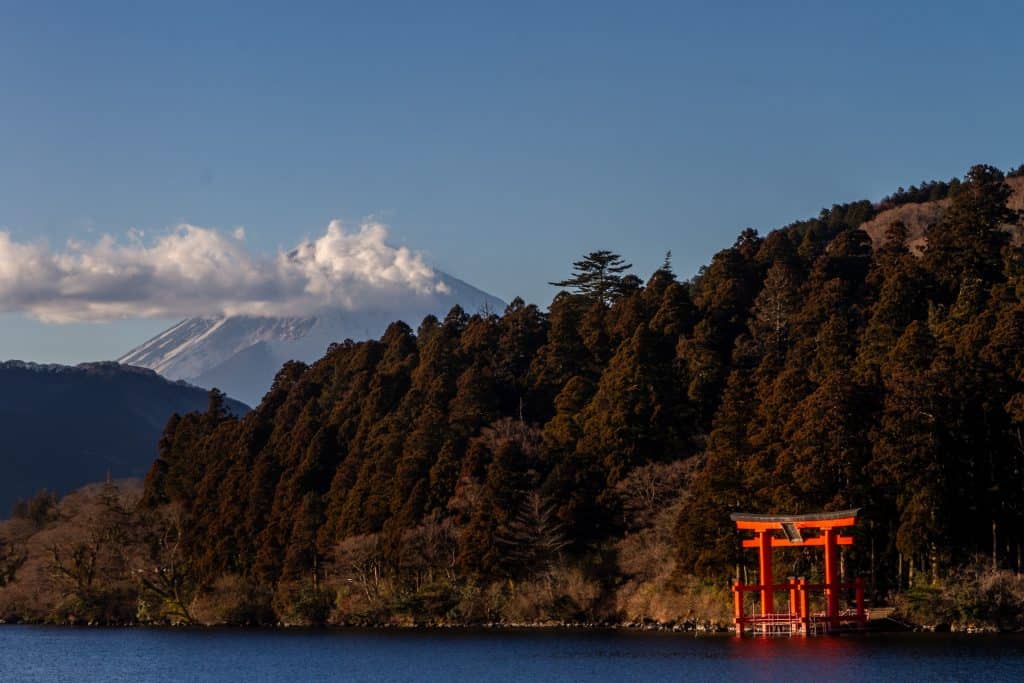
While I would consider almost any time of year to be a great time to visit Hakone, this is the time I’d recommend the most.
First, and perhaps most obviously is the stunning color of the leaves. Kōyō (changing color of the leaves) only lasts a very short time (similar to the cherry blossom), but if you manage to catch it, seeing it somewhere like Hakone would be spectacular.
Another reason is that Autumn gives you the perfect evening temperatures to enjoy the onsen. Summer is HOT in Japan, Winter is flipping freezing which may put a spanner in your plans for daytime plans, and spring is… Spring is pretty great to be fair.
Anyway, the slightly cooler evenings are the perfect temperature to enjoy the one thing Hakone is so well known for, Onsen. So if you can make it happen around this time, it’s well worth it!
Nikko

Autumn in Nikko paints the landscape with a breathtaking palette of rich and vibrant colors. For that reason, I would again recommend autumn as the time to see Nikko as well.
I’ve been to Nikko in the autumn, and you can see the tree leaves changing colors higher in the mountains and working their way down the valley. I think I was about 1-2 weeks too early for the peak, but it was still 100% worth it.
Just be prepared, autumn is probably the second busiest time to be traveling in Japan after Spring. We took the car in and were stuck in traffic for quite a few hours before we got moving again.
However, we managed to avoid most of the tourists and people just like we avoid the crowds in Japan: by walking a little further.
One of the most popular spots to admire the autumn foliage is Lake Chuzenji. Surrounded by majestic mountains, the lake offers a serene setting to witness this seasonal transformation. Whether you choose to stroll along its shores or take a boat ride, the panoramic views of the vivid autumn colors reflecting on the water are genuinely incredible.
Additionally, the nearby Senjogahara Marshland showcases a unique contrast of golden grasses and fiery leaves, creating a picturesque landscape that’s perfect for photography enthusiasts. I’ve also always wanted to visit here, so I’ll be super jealous of you!
Budget and expenses
There are more than enough options to make either of these places suit any kind of budget. From single day trip and local trains, to limited express trains and luxury onsen, you’ll be able to add it into any kind of itinerary.
Hakone
It completely depends on where you stay and what you plan on doing, but in general, Hakone can be expensive. I think a lot of that expense comes from its location and global recognition as an onsen town.
It’s frequently recommended to most people traveling to Japan, especially if they’re visiting Tokyo. To be honest, I don’t blame people for doing so because it’s such a beautiful place.
Luckily there are other alternatives if you still want to be in close proximity but can’t stomach the high costs of a ryokan in central Hakone.
Yumoto is the gateway town to Hakone and it’s definitely a little cheaper compared to some of the more central areas. If you want to be close but can’t afford to be central, give this area some thought.
Odawara is another option and is great if you want to stay somewhere a little more urban and just visit Hakone for the day (about 30 minutes away). This is the place we got the train to from Tokyo, as it connects to Kyoto (our final destination) via Shinkansen.
Pretty handy to have somewhere so close to Hakone with such great travel links to the rest of the country!
Expect to pay around $200 for a decent Ryokan (including dinner) experience for the two of you. Depending on where in Hakone your stay and the time of year you’re booking, that price could be for each or for both of you.
In terms of how much activities cost, and getting to Hakone like we discussed at the beginning, I’d recommend checking out the Hakone Freepass which bundles a lot of these things together for one price. If you’re staying for 2-3 days, it could absolutely be worth the price!
Nikko
Everything in Nikko is fairly clumped together, and you’ll just need to hop on the train if you want to visit another part of it. As we all know, trains in Japan are incredibly reliable and, in my opinion, very cheap, so transport won’t pose a problem.
If you’re a fan of walking or natural /outdoor activities then you won’t need much money to keep yourself entertained. There are a few temples and day trips you can do from Nikko that will cost a bit, but they’re totally optional and there’s more than enough to do in the city whether you want to spend a lot or a little.
Which destination should you choose?
This is one of the hardest ‘vs’ articles I’ve done on this site, and to be honest, there’s no definitive answer. That said, I think you can decide which to visit if you’ve only got the chance to go to one.
While both destinations are in some ways incredibly similar, my personal opinion is that you should visit Hakone if you get the chance. Provided you don’t visit during any of the busy periods in Japan, I personally think the area is a little more ‘zen’ and truly makes you feel like you’re in the middle of nowhere. Plus you can easily hop onto the shinkansen at Odawara to continue your journey to Kyoto if you chose to.
I’ve actually written an entire article about Kyoto vs Nikko which explains whether you’ll need to visit both, and which one you should chose if you’ve only got time/interest in visiting one.
Prefer a day trip somewhere slightly further south? I ventured all the way down to Hiroshima to figure out once and for all whether Miyajima was worth visiting. Spoiler alert: It was!





